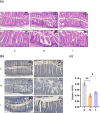Investigating the modulatory effects of lactoferrin on depressed rats through 16S rDNA gene sequencing and LC-MS metabolomics analysis
- PMID: 39333605
- PMCID: PMC11437287
- DOI: 10.1038/s41598-024-72793-2
Investigating the modulatory effects of lactoferrin on depressed rats through 16S rDNA gene sequencing and LC-MS metabolomics analysis
Erratum in
-
Publisher Correction: Investigating the modulatory effects of lactoferrin on depressed rats through 16S rDNA gene sequencing and LC-MS metabolomics analysis.Sci Rep. 2025 Mar 14;15(1):8861. doi: 10.1038/s41598-025-93235-7. Sci Rep. 2025. PMID: 40087341 Free PMC article. No abstract available.
Abstract
Lactoferrin is a natural multifunctional glycoprotein with potential antidepressant-like effects. However, the mechanism of its antidepressant effect has not been explored from the perspective of gut flora metabolism. Therefore, we employed both 16S rDNA gene sequencing and LC-MS metabolomics analysis to investigate the regulatory effects and mechanisms of lactoferrin in a rat model of depression. After one week of acclimatization, twenty-four 7-week-old male Sprague-Dawley rats were randomly and equally assigned into three groups: the control group, the model group, and the lactoferrin intervention group. The control group rats were housed under standard conditions, while the rats in the model and lactoferrin intervention groups were individually housed and exposed to chronic unpredictable mild stress for 44 days simultaneously. The lactoferrin intervention group was provided with water containing 2% lactoferrin (2 g/100 ml). Behavioural tests were conducted at week 7. Upon completion of the behavioral tests, the rats were anesthetized with isoflurane, humanely euthanized using a rat guillotine, and tissue samples were collected for further experiments. The results indicated that lactoferrin intervention led to an increase in sucrose solution consumption, horizontal movement distance, number of cross platforms, and residence time in the target quadrant. Additionally, it resulted in an increase in jejunal tight junction protein ZO-1 expression and a suppression of serum expression of inflammatory factors, Lipopolysaccharide and Diamine oxidase. In summary, lactoferrin can regulate the metabolic disorder of intestinal flora, reduce intestinal permeability, and further regulate the metabolic balance of hippocampal tissues through the microbiota-gut-brain axis. This process ultimately alleviates the depression-like behavior in rats.
Keywords: Depression; Gut microbiota; Lactoferrin; Metabolic disorders; Microbiota-gut-brain axis.
© 2024. The Author(s).
Conflict of interest statement
The authors declare no competing interests.
Figures










Similar articles
-
Multi-omics reveals the mechanisms of antidepressant-like effects of the low polarity fraction of Bupleuri Radix.J Ethnopharmacol. 2020 Jun 28;256:112806. doi: 10.1016/j.jep.2020.112806. Epub 2020 Mar 29. J Ethnopharmacol. 2020. PMID: 32234596
-
Integrated colon microbiome and metabolomics to elucidate the antidepressant mechanisms of the Radix Bupleuri-Radix Paeoniae Alba herb pair.Metab Brain Dis. 2024 Nov 28;40(1):45. doi: 10.1007/s11011-024-01450-4. Metab Brain Dis. 2024. PMID: 39607539
-
Fecal metabolomics combined with metagenomics sequencing to analyze the antidepressant mechanism of Yueju Wan.J Pharm Biomed Anal. 2024 Jan 20;238:115807. doi: 10.1016/j.jpba.2023.115807. Epub 2023 Oct 21. J Pharm Biomed Anal. 2024. PMID: 37924576
-
Variations in gut microbiota and fecal metabolic phenotype associated with depression by 16S rRNA gene sequencing and LC/MS-based metabolomics.J Pharm Biomed Anal. 2017 May 10;138:231-239. doi: 10.1016/j.jpba.2017.02.008. Epub 2017 Feb 10. J Pharm Biomed Anal. 2017. PMID: 28219800
-
Jasmine tea extract prevents CUMS-induced depression-like behaviors through the modulation of microbiota-gut-brain axis.Food Res Int. 2025 May;209:116214. doi: 10.1016/j.foodres.2025.116214. Epub 2025 Mar 14. Food Res Int. 2025. PMID: 40253129
References
-
- Monroe, S. M. & Harkness, K. L. Major depression and its recurrences: life course matters. Annu. Rev. Clin. Psychol.18, 329–357 (2022). - PubMed
MeSH terms
Substances
Grants and funding
- 2023LHMS03065/Natural Science Foundation of Inner Mongolia Autonomous Region
- 2023LHMS03065/Natural Science Foundation of Inner Mongolia Autonomous Region
- 2023LHMS03065/Natural Science Foundation of Inner Mongolia Autonomous Region
- 2023LHMS03065/Natural Science Foundation of Inner Mongolia Autonomous Region
- 2023LHMS03065/Natural Science Foundation of Inner Mongolia Autonomous Region
LinkOut - more resources
Full Text Sources
Medical

